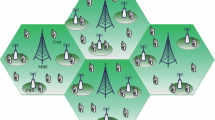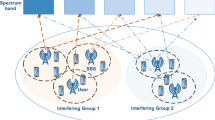Abstract
Ultra-dense heterogeneous networks (UDHNs) have been widely regarded as a promising solution to enhance the reuse efficiency of spatial frequency and thus improve the overall network performance. In such networks, a load balancing problem caused by coexisting macrocells and small cells should be treated seriously, which means some effective user associations are essential for load balancing. To this end, we design two types of offloading (load balancing) schemes for UDHNs to maximize a logarithmic utility of long-term rates. To guarantee the load balancing gain, a frequency partitioning scheme is designed to degrade the cross-plane interference, and a time partitioning strategy is developed to eliminate the strong interference received by some users offloaded from macrocells. In these offloading schemes, the main difference between them is whether a time partitioning factor needs to be optimized. As for the problems formulated in these schemes, we design a distributed algorithm by utilizing dual decomposition and develop a centralized algorithm with a two-layer iteration. Then, we give some detailed convergence and complexity analyses for them. Numerical results show that the proposed schemes yield some significant performance gains relative to some traditional ones, and the centralized algorithm often achieves a better association performance than a distributed one since the former almost always tries to optimize a time partitioning factor.










Similar content being viewed by others
References
Lpez-Prez DD, Claussen H, et al (2015) Towards 1 gbps/UE in cellular systems: understanding ultra-dense small cell deployments. IEEE Commun Surv Tut 17(4):2078–2101
Galinina O, Pyattaev A, Andreev S et al (2015) 5G multi-RAT LTE-WiFi ultra-dense small cells: performance dynamics, architecture, and trends. IEEE J Sel Areas Commun 33(6):1224–1240
Koudouridis G, Soldati P (2017) Spectrum and network density management in 5G ultra-dense networks. IEEE Wireless Commun 24(5):30–37
Zheng J, Wu Y, Zhang N, et al (2017) Optimal power control in ultra-dense small cell networks: a game-theoretic approach. IEEE Trans Wireless Commun 16(7):4139–4150
Yunas S, Valkama M, Niemel J (2015) Spectral and energy efficiency of ultra-dense networks under different deployment strategies. IEEE Commun Mag 53(1):90–100
Kamel M, Hamouda W, Youssef A (2017) Performance analysis of multiple association in ultra-dense networks. IEEE Trans Commun 65(9):3818–3831
Chen S, Zhao T, Chen H, et al (2017) Performance analysis of downlink coordinated multipoint joint transmission in ultra-dense networks. IEEE Netw 31(5):106–114
Agyapong P, Iwamura M, Staehle D, et al (2014) Design considerations for a 5G network architecture. IEEE Commun Mag 52(11):65–75
Ge X, Tu S, Mao G et al (2016) 5G ultra-dense cellular networks. IEEE Wireless Commun 23(1):72–79
Du J, Gelenbe E, Jiang C, et al (2017) Contract design for traffic offloading and resource allocation in heterogeneous ultra-dense networks. IEEE J Sel Areas Commun 35(11):2457– 2467
Zhou T, Liu Z, Zhao J, et al (2017) Joint user association and power control for load balancing in downlink heterogeneous cellular networks. IEEE Trans Veh Technol 67(3):2582– 2593
Zhou T, Liu Z, Qin D, et al (2017) User association with maximizing weighted sum energy efficiency for massive MIMO-enabled heterogeneous cellular networks. IEEE Commun Lett 21(10):2250–2253
Andrews J, Singh S, Ye Q, et al (2014) An overview of load balancing in HetNets: old myths and open problems. IEEE Wireless Commun 21(2):18–25
Liu D, Wang L, Chen Y, et al (2016) User association in 5G networks: a survey and an outlook. IEEE Commun Surv Tut 18(2):1018–1044
Khandekar A, Bhushan N, Tingfang J, et al (2010) LTE-Advanced: heterogeneous networks. European Wireless Conference (EW), Lucca Italy, pp 978–982
Jo H, Sang Y, Xia P, et al (2012) Heterogeneous cellular networks with flexible cell association: a comprehensive downlink SINR analysis. IEEE Trans Wireless Commun 11(10):3484–3495
Yu G, Zhang Z, Qu F, et al (2017) Ultra-dense heterogeneous networks with full-duplex small cell base stations. IEEE Netw 31(6):108–114
Zhang T, Zhao J, An L, et al (2016) Energy efficiency of base station deployment in ultra dense HetNets: a stochastic geometry analysis. IEEE Wireless Commun Lett 5(2):184–187
Ye Q, Rong B, Chen Y, et al (2013) User association for load balancing in heterogeneous cellular networks. IEEE Trans Wireless Commun 12(6):2706–2716
Shen K, Yu W (2014) Distributed pricing-based user association for downlink heterogeneous cellular networks. IEEE J Sel Areas Commun 32(6):1100–1113
Chen Y, Li J, Lin Z, et al (2016) User association with unequal user priorities in heterogeneous cellular networks. IEEE Trans Veh Technol 65(9):7374–7388
Son K, Kim H, Yi Y, et al (2011) Base station operation and user association mechanisms for energy-delay tradeoffs in green cellular networks. IEEE J Sel Areas Commun 29(8):1525– 1536
Moon S, Kim H, Yi Y (2016) Brute: energy-efficient user association in cellular networks from population game perspective. IEEE Trans Wireless Commun 15(1):663–675
Cho S, Choi W (2013) Energy-efficient repulsive cell activation for heterogeneous cellular networks. IEEE J Sel Areas Commun 31(5):870–882
Du B, Pan C, Zhang W, et al (2014) Distributed energy-efficient power optimization for coMP systems with max-min fairness. IEEE Commun Lett 18(6):999–1002
Luo S, Zhang R, Lim T (2015) Downlink and uplink energy minimization through user association and beamforming in c-RAN. IEEE Trans Wireless Commun 14(1):494– 508
Singh S, Andrews J (2014) Joint resource partitioning and offloading in heterogeneous cellular networks. IEEE Trans Wireless Commun 13(2):888–901
Sun Y, Li S, Yang L (2018) Green fronthaul allocation and power management in cloud-RAN. Eurasip J Wireless Commun Netw 2018(1):1–18
Zhou T, Huang Y, Yang L (2015) Joint user association and interference mitigation for D2D-enabled heterogeneous cellular networks. Mobile Netw Appl 21(4):1–14
Han T, Mao G, Li Q, et al (2015) Interference minimization in 5G heterogeneous networks. Mobile Netw Appl 20(6):756– 762
Wang B, Kong Q, Yang L (2015) Context-aware user association for energy cost saving in a green heterogeneous network with hybrid energy supplies. Mobile Netw Appl 2015
Tang W, Zhang R, Liu Y (2014) Joint resource allocation for eICIC in heterogeneous networks. IEEE GLOBECOM: 2011–2016
Deb S, Monogioudis P, Miernik J (2014) Algorithms for enhanced inter-cell interference coordination (eICIC) in LTE HetNets. IEEE/ACM Trans Netw 22(1):137–150
Liu C, Li M, Hanly S (2017) Joint downlink user association and interference management in two-tier HetNets with dynamic resource partitioning. IEEE Trans Veh Technol 66(2):1365– 1378
Zhou T, Huang Y, Yang L (2016) Energy-efficient user association in downlink heterogeneous cellular networks. IET Commun 10(13):1553–1561
Liu Y, Fang X (2016) Joint user association and resource allocation for self-backhaul ultra-dense networks. China Commun 13(2):1–10
Gotsis A, Stefanatos S, Alexiou A (2015) Optimal user association for massive MIMO empowered ultra-dense wireless networks. In: Proc IEEE ICCW, London UK, pp 2238– 2244
Bottai C, Cicconetti C, Morelli A, et al (2014) Energy-efficient user association in extremely dense small cell networks. In: Proc euCNC, Bologna Italy, 2014, pp 1–5
Xiao L, Johansson M, Boyd S (2004) Simultaneous routing and resource allocation via dual decomposition. IEEE Trans Commun 52(7):1136–1144
Boyd S, Xiao L, Mutapcic A (2003) Subgradient methods. Online: https://web.stanford.edu/class/ee392o/subgrad_method.pdf, Accessed Oct 2003
Boyd S, Vandenberghe L (2004) Convex optimization. Cambridge University Press, Cambridge
Fooladivanda D, Rosenberg C (2013) Joint resource allocation and user association for heterogeneous wireless cellular networks. IEEE Trans Wireless Commun 12(1):248– 257
Acknowledgments
This work was supported by National Natural Science Foundation of China under Grant Nos. 61861017, 61861018, 61862025, 61761019, 61862024, 61761030, 61422105, 61671144, 61372101 and 61221002, Natural Science Foundation of Jiangxi Province of China under Grant Nos. 20181BAB211013 and 20181BAB211016, Foundation of Jiangxi Educational Committee of China under Grant No. GJJ170414.
Author information
Authors and Affiliations
Corresponding author
Additional information
Publisher’s Note
Springer Nature remains neutral with regard to jurisdictional claims in published maps and institutional affiliations.
Rights and permissions
About this article
Cite this article
Zhou, T., Zhao, J., Qin, D. et al. Joint User Association and Time Partitioning for Load Balancing in Ultra-Dense Heterogeneous Networks. Mobile Netw Appl 26, 909–922 (2021). https://doi.org/10.1007/s11036-019-01351-2
Published:
Issue Date:
DOI: https://doi.org/10.1007/s11036-019-01351-2




